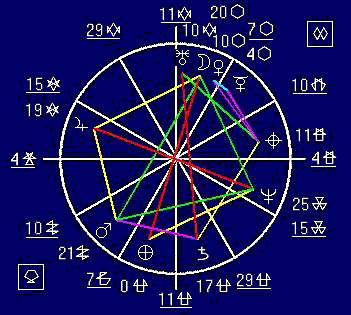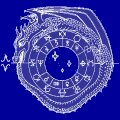Galactic Astrology : Example Chart
Carl Jung: Galactic chart
Born on the 26th July 1875 at 7.44 p.m. C.E.T. in Thurgau, Switzerland (48N, 8E), Jung was an early associate of Freud, but separated from him in 1912 when he published the 'Psychology of the Unconscious'. This work introduced the concept of the 'collective unconscious' which he intended as a complementary idea to the personal unconscious in Freud's work. Jung rejected the emphasis on sexuality as the fundamental human drive and instead sought to understand the unconscious mind by analysing the symbolism of religious experience, myths, fairy tales and dreams. He believed the 'collective unconscious' consisted of 'archetypes' i.e. images, symbols, or narratives common either to members of a culture or to humanity as a whole. Jung also created the term 'synchronicity' to describe the co-incidence of events connected in meaning, but not causally, and introduced the introversion-extroversion distinction in personality theory.
 |
|
In the Galactic chart Jung's contribution to the world is clearly shown by the position of the Earth in Nurture in the house of Growth and Decay. He was essentially a nourisher/cultivator who fostered the development and fruition of things he was involved with. Yet, with the Moon in Rule he would be seen as an figurehead, possibly a somewhat authoritarian leader in the field of interpretation. Its opposition to the Earth suggests this could over-shadow his real importance. However, this aspect is eased through Neptune showing a concern for the inner world and his relationship with the Divine: "who looks outside dreams, who looks inside wakes", he wrote. Neptune is in Build in the house of Gains & Losses; for Jung the spiritual was characterised by fundamental patterns ('archteypes') which he undoubtedly 'collected'.
The Moon is involved in a kite pattern with Mars, Neptune and Jupiter. Mars indicates an identification with his creative potential in the realm of Explorations and Evasions and a willingness to delve into the unknown to uncover its secrets. Like the Moon, it points to an ability to lead and inspire, but as a choice rather than how he was perceived or wanted to be perceived. Taken as a whole, the grand trine suggests that the more he identified (Mars) with the inner world (Neptune) the more he would become the authoratative interpreter (Moon), the more he sought the Divine the more he would choose to inspire others through his explorations using his role as authoratative interpreter, and the more authoratative an interpreter he became the more he would probe the inner world. The opposition in a kite ties down the energy within the grand trine giving it purpose. Since Jupiter is the focus, Jung may well have realised that his own development rested on teaching, disseminating or otherwise drawing out from others the meaning of his Moon/Mars/Neptune configuration.
Saturn and Uranus are in opposition also, eased by Pluto. Saturn shows one's attachments and ambitions. In Nurture and the House of Construction and demolition, Jung understood himself to be a fosterer of growth dealing with building up or pulling down. (He founded the discipline of Analytical Psychology and attempted to show the limitations of Freudian psychology.) Uranus suggests his true creativity lay in the realm of reformulation and consequently interpreting for others - indeed, much of his work involved the analysis of dreams. Pluto shows that he accessed essence through interactions and exchanges concerning health and illness. This raises the intriguing possibility that during consultations he could tap into his essence and both nurture and interpret the client at once. Yet the squares from Mercury and Venus in Rule could have hampered him. These represent an awareness of and a passion for authority with Mercury perceiving empowerment or slavery, and Venus driving him to interpret.
Lastly, Jung's ascendent is in Protect. His prime lesson in life was to maintain the integrity of whatever he perceived as the Highest. It was his karma to dedicate himself to, even to revere those things he regarded as truly important.
D.C.
[Top]
© The Astrological Society






